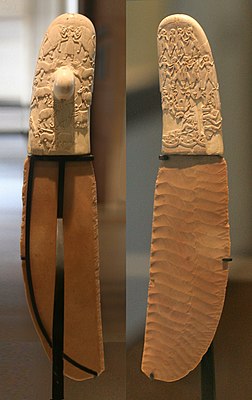| Gebel el-Arak Knife | |
|---|---|
 The Gebel el-Arak knife (back and front), on display at the Musée du Louvre. | |
| Material | Elephant ivory, flint |
| Size | 25.5 centimetres (10.0 in) |
| Created | Naqada II d from c. 3450 BC[1] |
| Discovered | Bought by Georges Aaron Bénédite in Cairo from antique dealer M. Nahman, February 1914 |
| Present location | Musée du Louvre, Sully wing, room 633 |
| Identification | E 11517[2] |
The Gebel el-Arak Knife, also Jebel el-Arak Knife, is an ivory and flint knife dating from the Naqada II period of Egyptian prehistory (3500—3200 BC), showing Mesopotamian influence. The knife was purchased in 1914 in Cairo by Georges Aaron Bénédite for the Louvre, where it is now on display in the Sully wing, room 633.[3][4] At the time of its purchase, the knife handle was alleged by the seller to have been found at the site of Gebel el-Arak, but it is today believed to come from Abydos.
- ^ Cite error: The named reference
delangewas invoked but never defined (see the help page). - ^ "Site officiel du musée du Louvre". cartelfr.louvre.fr.
- ^ Mark, Samuel (2006). From Egypt to Mesopotamia: a Study of Predynastic Trade Routes (new ed.). Texas A & M University Press. ISBN 978-1585445301..
- ^ Conference, William Foxwell Albright Centennial (1996). The Study of the Ancient Near East in the Twenty-first Century: The William Foxwell Albright Centennial Conference. Eisenbrauns. p. 10. ISBN 978-0-931464-96-6.